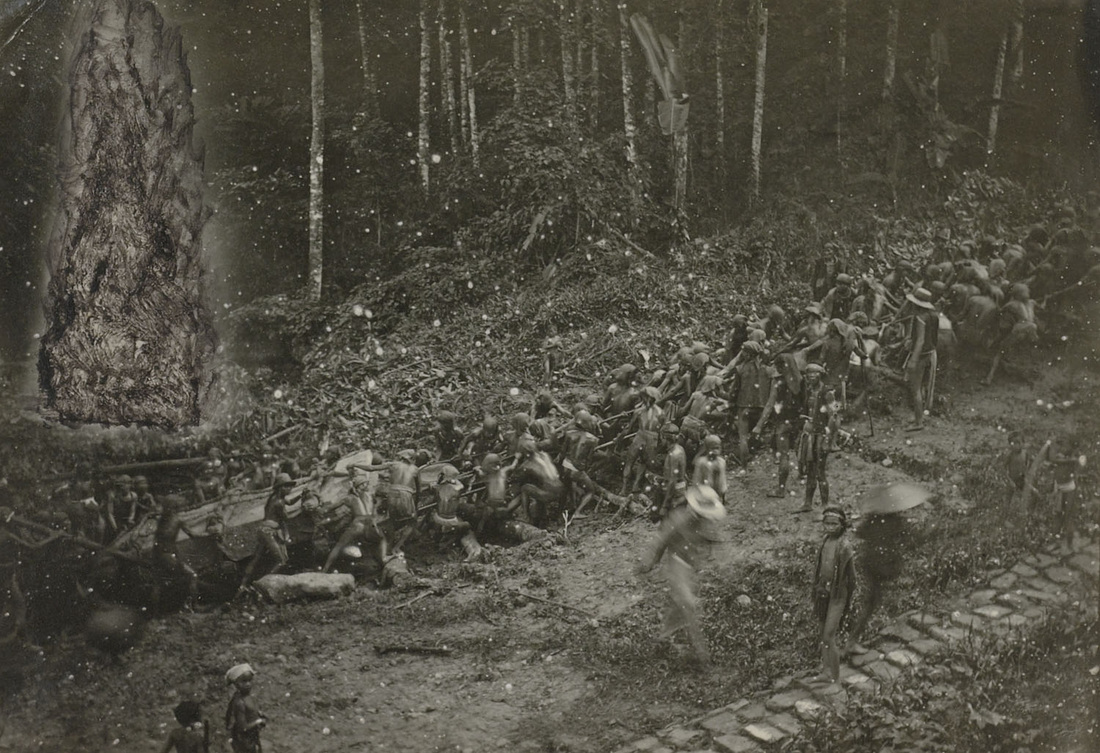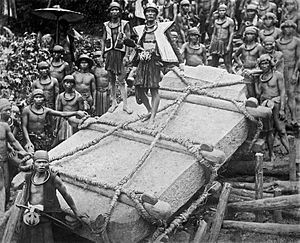It looks like you're using an Ad Blocker.
Please white-list or disable AboveTopSecret.com in your ad-blocking tool.
Thank you.
Some features of ATS will be disabled while you continue to use an ad-blocker.
share:
All of this is seems to be explained in the Urantia Book. Several of the papers in it talk about the development of humanity and how it spread around
the world.
78:5.6 (873.2) These Andites were the so-called Dravidian and later Aryan conquerors of India; and their presence in central Asia greatly upstepped the ancestors of the Turanians. Many of this race journeyed to China by way of both Sinkiang and Tibet and added desirable qualities to the later Chinese stocks. From time to time small groups made their way into Japan, Formosa, the East Indies, and southern China, though very few entered southern China by the coastal route.
78:5.7 (873.3) One hundred and thirty-two of this race, embarking in a fleet of small boats from Japan, eventually reached South America and by intermarriage with the natives of the Andes established the ancestry of the later rulers of the Incas. They crossed the Pacific by easy stages, tarrying on the many islands they found along the way. The islands of the Polynesian group were both more numerous and larger then than now, and these Andite sailors, together with some who followed them, biologically modified the native groups in transit. Many flourishing centers of civilization grew up on these now submerged lands as a result of Andite penetration. Easter Island was long a religious and administrative center of one of these lost groups. But of the Andites who navigated the Pacific of long ago none but the one hundred and thirty-two ever reached the mainland of the Americas.
And so the culture of Mesopotamia quietly spread out over Europe, India, China, northern Africa, and the Pacific Islands.
Source
edit on 2/11/2022 by trollz because: (no reason given)
edit on 2/11/2022 by trollz because: (no reason
given)
edit on 2/11/2022 by trollz because: (no reason given)
Some sources claim sound was used both to saw through stone and to move stones nearly weightlessly. And to heal in sound healing chambers with
different frequencies to attack different ailments. There’s an experiment where they pass a frequency thru a copper wire on YouTube and it vibrates
right thru granite. Wish I saved the link.
originally posted by: AlexandrosTheGreat
Some sources claim sound was used both to saw through stone and to move stones nearly weightlessly. And to heal in sound healing chambers with different frequencies to attack different ailments. There’s an experiment where they pass a frequency thru a copper wire on YouTube and it vibrates right thru granite. Wish I saved the link.
However, the AE left images on walls and on pottery showing normal masonry work with common tools - and the rocks themselves show clear evidence of the use of pounders, saws & drills (with abrasives), pecking, abrasive use and use of rock spiting.
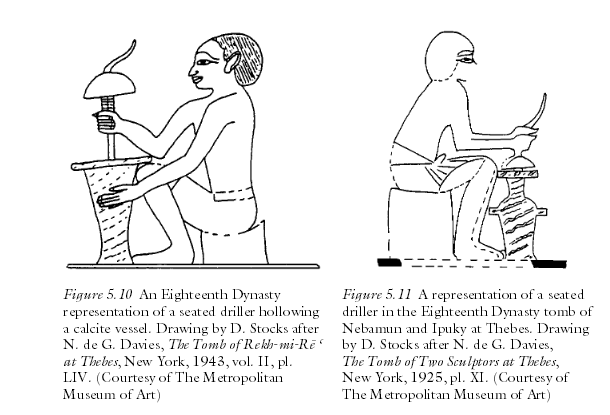
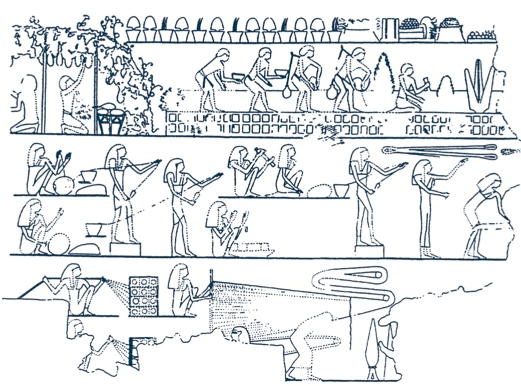
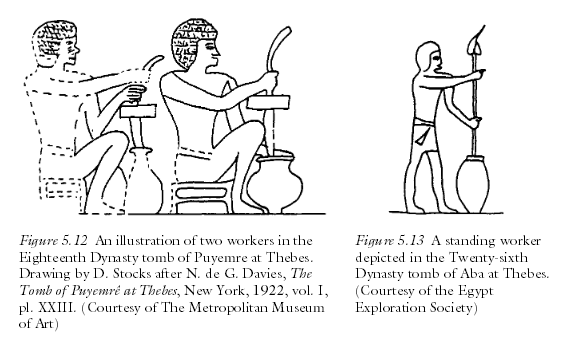
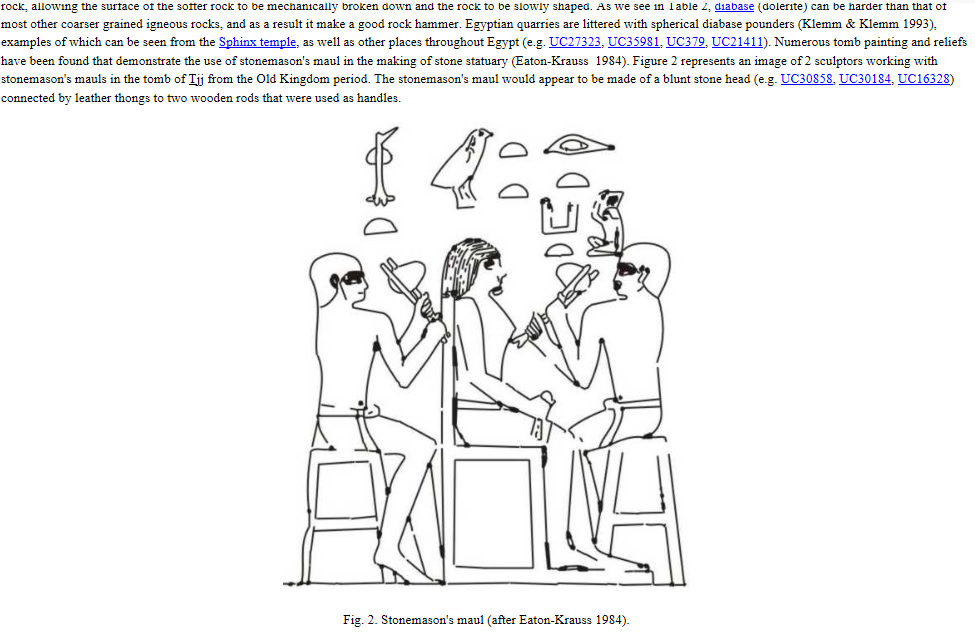

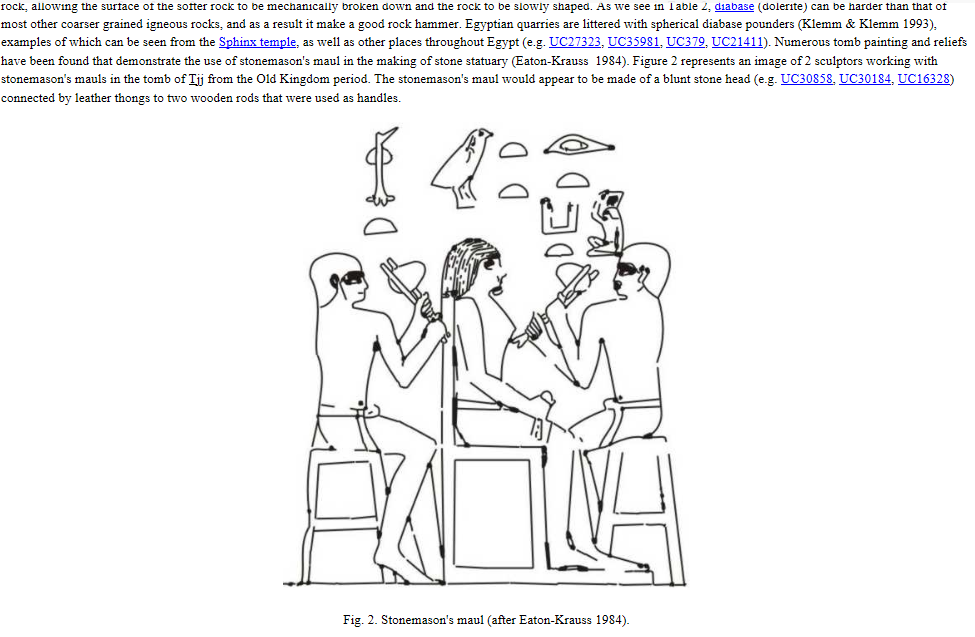
imgur.com...
imgur.com...
imgur.com...
imgur.com...
imgur.com...
imgur.com...
imgur.com...
originally posted by: KKLOCO
Are you really going to compare the size of the blocks in your pics to Baalbek’s?
Context is important here. That’s the point.
The context is that I was showing evidence in regards to this question.
originally posted by: merka That idea that modern humans dont have the technology to lift the "heavy" stones of the past remains as accurate as saying modern humans have too weak arms to open doors because they play too much consoles.
No mention of Baalbek so an incorrect an invalid statement.
Context - Yes it is. They moved stones by dragging them. Very very few extremely heavy stones were moved by ancient man. So do you agree we have evident of people using muscle power to move heavy stones?
One of 1,000 tons in Egypt
Three 800 ton one's at Baalbek
two 720 ton Colossi in Egypt
35-40 400 ton stones for Khafre and Sphinx temple (moved about 100 meters)
250 ton western stone
en.wikipedia.org...
You know why so few really heavy stones were ever moved? It was really, really difficult
a number of 220 ton stones in Menkaure's pyramid
originally posted by: Hanslune
originally posted by: merka That idea that modern humans dont have the technology to lift the "heavy" stones of the past remains as accurate as saying modern humans have too weak arms to open doors because they play too much consoles.
No mention of Baalbek so an incorrect an invalid statement.
Context - Yes it is. They moved stones by dragging them. Very very few extremely heavy stones were moved by ancient man. So do you agree we have evident of people using muscle power to move heavy stones?
One of 1,000 tons in Egypt
Three 800 ton one's at Baalbek
two 720 ton Colossi in Egypt
35-40 400 ton stones for Khafre and Sphinx temple (moved about 100 meters)
250 ton western stone
en.wikipedia.org...
You know why so few really heavy stones were ever moved? It was really, really difficult
a number of 220 ton stones in Menkaure's pyramid
That has nothing to do with what I stated though. People keep arguing in the line of "a 200 ton stone? I CANT LIFT THAT ALONE SO IT MUST BE IMPOSSIBLE!".
Of course it was hard. And it took many thousands of people and a long time to do.
But we can still do far, far better today with all the technology and advanced engineering at our disposal. 1000 ton? Featherweight. We just dont use it to build giant stone pyramids, because that would be stupid.
a reply to: Akragon
Videos like that highlight what a narrow-minded group of people scientists are.
They prefer if we treat them like deities and not question their knowledge - because then you are "against science". We are supposed to regard science as the Next Big Thing in religion, and characters like Tyson, Kaku and that ridiculous hack Nye are the priests that know the truth and nothing but the truth.
Yet, they are like Bambi on ice whenever something comes up that goes against anything or everything they have been preaching from their temple. They shuffle their feet, they twiddle their thumbs and declare it "fake news", "conspiracy theories" and want people to forget all about it.
How many literal tons of stuff have well-meaning citizens of the USA shipped to the Smithsonian, only to have it disappear - because it didn't fit the Holy Narrative of science of the day?
How long are we supposed to respect these people just because they belong to a sacred circle that peer review each other and disregard anything coming from outside their own club?
People need to wake up and realize that scientists are just giving their best estimate of stuff - and coming up with some excuse whenever something invalidates their math. They are doing advanced guesswork, presenting it as sacred truths that nobody should question.
That's exactly what we all need to do. Question everything. Follow the money - because whoever pays for science and research most definitely have an agenda of their own.
And that agenda is not in the best interest of the general population.
Videos like that highlight what a narrow-minded group of people scientists are.
They prefer if we treat them like deities and not question their knowledge - because then you are "against science". We are supposed to regard science as the Next Big Thing in religion, and characters like Tyson, Kaku and that ridiculous hack Nye are the priests that know the truth and nothing but the truth.
Yet, they are like Bambi on ice whenever something comes up that goes against anything or everything they have been preaching from their temple. They shuffle their feet, they twiddle their thumbs and declare it "fake news", "conspiracy theories" and want people to forget all about it.
How many literal tons of stuff have well-meaning citizens of the USA shipped to the Smithsonian, only to have it disappear - because it didn't fit the Holy Narrative of science of the day?
How long are we supposed to respect these people just because they belong to a sacred circle that peer review each other and disregard anything coming from outside their own club?
People need to wake up and realize that scientists are just giving their best estimate of stuff - and coming up with some excuse whenever something invalidates their math. They are doing advanced guesswork, presenting it as sacred truths that nobody should question.
That's exactly what we all need to do. Question everything. Follow the money - because whoever pays for science and research most definitely have an agenda of their own.
And that agenda is not in the best interest of the general population.
a reply to: Hanslune
What I would consider the topic of this thread is that this supposed advanced civilization roamed the earth long before the ancient Egyptians, which later evolved in a different paradigm and didn't use the same techniques.
You can in fact see a clear difference between the techniques used in what are believed to be the "antediluvian" structures when compared to the dynastic Egyptian ones.
Moreover, if we consider this theory and try to connect it to what scholars that lived during that era wrote, such as Manetho, this previous civilization which dozens of ancient historians spoke about wasn't even accustomed to writing or leaving documents and such. As Manetho continues, foreseeing a natural catastrophe (which would be that of the Younger Dryas, and concerning dates, Manetho comes close to the event just like Plato did), only left evidence of their legacy written in megalithic pillars, which unfortunately ancient egyptians were not able to read.
What I would consider the topic of this thread is that this supposed advanced civilization roamed the earth long before the ancient Egyptians, which later evolved in a different paradigm and didn't use the same techniques.
You can in fact see a clear difference between the techniques used in what are believed to be the "antediluvian" structures when compared to the dynastic Egyptian ones.
Moreover, if we consider this theory and try to connect it to what scholars that lived during that era wrote, such as Manetho, this previous civilization which dozens of ancient historians spoke about wasn't even accustomed to writing or leaving documents and such. As Manetho continues, foreseeing a natural catastrophe (which would be that of the Younger Dryas, and concerning dates, Manetho comes close to the event just like Plato did), only left evidence of their legacy written in megalithic pillars, which unfortunately ancient egyptians were not able to read.
a reply to: merka
They have actually tried to carry and lift blocks weighing dozens of tonnes, and the results were ludicrous. Ever seen some of the videos?
Moreover, what people often don't consider, is that these blocks weren't just dragged. If we consider Baalbek, but I could mention dozens of megalithic sites, is that such stones were lifted in the air and carefully placed on top of other stones.
To perform such a maneuver, the precision required would be astounding, given that you can't move an 800 tonnes block when already placed on top of another, and doing so with rudimental instruments would be quite a task that could eventually end up in a disaster.
As I wrote in a previous comment on this thread, French architect Pierre Adams tried to replicate a wooden pulley machine that was able to lift such a block but failed miserably due to proportions (the machine should've been multiple times bigger, which in turn led to the obvious impossibility to maneuver it no matter how many people involved).
To answer your last statement, I don't think our ancestors were stupid. They could plan incredibly complex structures, using advanced geometry, mathematics, and engineering skills. They were very, very smart. Building with such enormous stones wasn't done out of stupidity as you suggest. If that was not convenient to them, they would've cut smaller blocks, because when you have the ability to cut a 100 tonnes block, you also have the ability to cut it smaller. That's a no-brainer to a civilization that knew how to use the golden ratio to place a building. Evidently, they could move those quite easily, as the theory of slave labor is nowadays discredited even by mainstream academia.
They have actually tried to carry and lift blocks weighing dozens of tonnes, and the results were ludicrous. Ever seen some of the videos?
Moreover, what people often don't consider, is that these blocks weren't just dragged. If we consider Baalbek, but I could mention dozens of megalithic sites, is that such stones were lifted in the air and carefully placed on top of other stones.
To perform such a maneuver, the precision required would be astounding, given that you can't move an 800 tonnes block when already placed on top of another, and doing so with rudimental instruments would be quite a task that could eventually end up in a disaster.
As I wrote in a previous comment on this thread, French architect Pierre Adams tried to replicate a wooden pulley machine that was able to lift such a block but failed miserably due to proportions (the machine should've been multiple times bigger, which in turn led to the obvious impossibility to maneuver it no matter how many people involved).
To answer your last statement, I don't think our ancestors were stupid. They could plan incredibly complex structures, using advanced geometry, mathematics, and engineering skills. They were very, very smart. Building with such enormous stones wasn't done out of stupidity as you suggest. If that was not convenient to them, they would've cut smaller blocks, because when you have the ability to cut a 100 tonnes block, you also have the ability to cut it smaller. That's a no-brainer to a civilization that knew how to use the golden ratio to place a building. Evidently, they could move those quite easily, as the theory of slave labor is nowadays discredited even by mainstream academia.
a reply to: Nihil0
Thanks for your contribution and welcome to ATS, I’m looking forward to checking out your website and looking into your work in more detail. Don’t expect to convince the die hard mainstream types on here though you will be wasting your time. Share your knowledge but don’t get sucked into “debates” as you might as well debate a brick wall.
I would like to share with you a very good documentary available on YouTube called Standing With Stones, it’s about the megaliths of Britain and puts forward opinions but isn’t pushing anything. The footage is really good like a virtual tour. I feel sights like Thornborough henge (similar layout to the Giza pyramids) weren’t just ceremonial sights they were very much connected to tracking the night sky, while they used rough blocks it’s also like they used such large stones and earthworks because they intended them to last well into the future. Maybe they were trying to tell us something?
Thanks for your contribution and welcome to ATS, I’m looking forward to checking out your website and looking into your work in more detail. Don’t expect to convince the die hard mainstream types on here though you will be wasting your time. Share your knowledge but don’t get sucked into “debates” as you might as well debate a brick wall.
I would like to share with you a very good documentary available on YouTube called Standing With Stones, it’s about the megaliths of Britain and puts forward opinions but isn’t pushing anything. The footage is really good like a virtual tour. I feel sights like Thornborough henge (similar layout to the Giza pyramids) weren’t just ceremonial sights they were very much connected to tracking the night sky, while they used rough blocks it’s also like they used such large stones and earthworks because they intended them to last well into the future. Maybe they were trying to tell us something?
I think the gods were astronauts, just like von Danicken said. Many of his findings are debunked. So what? I think the gods came from a wandering star
system. Scholtz's star system would have been a good candidate.
And our geniuses are not so far behind as those who created us. But we are making the same mistakes our creators did That doesn't bode well.
I wrote evawaseerst.be more than 10 years ago and I'm still believing in it. Feel free not to believe in it :-)
www.evawaseerst.be...:
And our geniuses are not so far behind as those who created us. But we are making the same mistakes our creators did That doesn't bode well.
I wrote evawaseerst.be more than 10 years ago and I'm still believing in it. Feel free not to believe in it :-)
www.evawaseerst.be...:
originally posted by: RAY1990
a reply to: Vroomfondel
Why can we not replicate them?
I've heard this a lot but it seems to me engineers or even a decent bricky never agrees. Why should they when we actually do have the ability to weave a cloth that can filter water or aim lasers over 384k km of space and bounce them off a mirror that's a couple of square feet. It's a bit short sighted to think we can't move a 1000 tonne stone a few miles when we've launched 100 tonne payloads into space.
The Taisun crane can lift 20,000 tonnes, Cleopatra's Needle weighed 200 tonnes and the transportation of that is well documented.
Ancient building techniques are well understood too, fire and water a great for splitting rocks. All you need is a starting line. This can be achieved by engraving a line then applying heat or drill tiny little holes, fill them with pegs then apply water.
All the meso-american structures were assumed to be built without metal but that's a debatable point since smelters that predate Columbus have been found, the Inca knew of metallurgy.
Seems no matter where we look they had the potential with the technology and the means available, I personally find it a bit ignorant to think people of history couldn't achieve these great works.
I see your point here.
I don’t think anyone is arguing that past civilizations didn’t have the technology. They obviously did - we can see and touch the output of the technology via the many ancient structures we study today. So, I don’t think anyone is calling them ignorant/stupid/primitive.
All of known human (or human-ish) history could have played out maybe 10 or 20k times in the course of earth’s history. To think we’re the peak all of advancement the planet has ever seen might be a stretch, arrogant, or flat out wrong.
There’s no shortage of mysteries around the subject of ancient structures. Tech, “why?”, etc. are all huge curiosities.
The question that I can’t answer is… what happened to these “people”? If they had the tech to create these megalithic structures out of exceptionally heavy material, how did they just go away (in some instances)? My train of thought is, If you can identify what happened to them then you might also figure out why the structures were built, how they were built and more. Work backwards, in a way.
I have some speculations but, like others, I don’t know the answer.
originally posted by: MarlbBlack
a reply to: Harte
I watch most if not all of history mystery and the dude from India, starts with a P.. lol It does bind the mind of why these polygonal walls and all the heavy lifting is throughout the entire planet.. I try to keep an open mind but dang if you have a better explanation then lets hear it? I am all ears because I find it very compelling...
What do you want explained?
Do you think, after a stone age that lasted well over 2 million years, that humans never figured out how to shape stone?
Or are you just wondering about how they were moved and placed?
Harte
originally posted by: starshift
The history they want you to believe is that we all evolved out of Africa. That story helps us remain manageable and ignorant of our true potential.
The earliest Homo Sapiens have been found in Africa.
Come up with some new finds that are older, and you might get some traction with that.
Harte
originally posted by: sraven
If you are able to carve and move a 16,000 pound stone,
surely you have the technology for masonry using a 1 pound bricks.
So, why does man build public works using 16,000 pound stones?
Because there is something outside the walls that can move a 15,000 pound stone.
They made brick ones too.
Harte
originally posted by: TonyS
a reply to: Akragon
Something is definitely up with this line of investigation. So, for example, there is a layer of hewn stones at the base of the Temple of Jupiter built by the Romans at Heliopolis. The ability to quarry, move and place these huge stones is beyond imagination and beyond anything the Romans could have done.
Actually, it's not.
Harte
originally posted by: KKLOCO
originally posted by: Hanslune
originally posted by: merka
That idea that modern humans dont have the technology to lift the "heavy" stones of the past remains as accurate as saying modern humans have too weak arms to open doors because they play too much consoles.
Yep, people were hauling around rocks for thousands of the year using muscle power. The last folks to do so for real (not Experimental archaeological recreations) were the Nias people in Sumatra and did so circa 1915.
en.wikipedia.org...
Are you really going to compare the size of the blocks in your pics to Baalbek’s?
Context is important here. That’s the point.
You realize those aren't Romans, don't you?
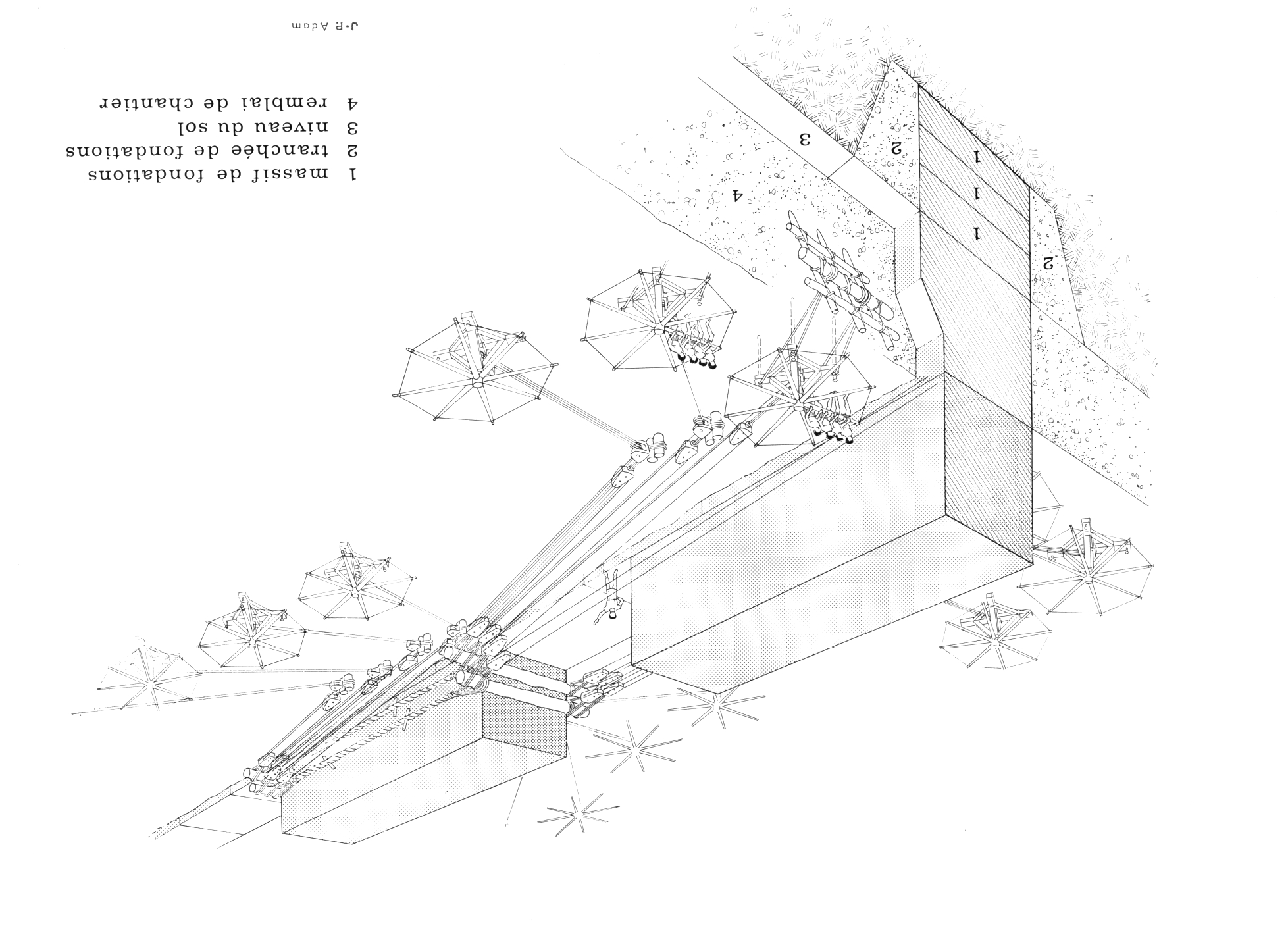
Harte
new topics
-
Let's Buy Greenland
General Chit Chat: 45 minutes ago -
Planned Civil War In Britain May Be Triggered Soon
Social Issues and Civil Unrest: 3 hours ago -
Claim: General Mark Milley Approved Heat and Sound Directed Energy Weapons During 2020 Riots
Whistle Blowers and Leaked Documents: 5 hours ago
top topics
-
Claim: General Mark Milley Approved Heat and Sound Directed Energy Weapons During 2020 Riots
Whistle Blowers and Leaked Documents: 5 hours ago, 8 flags -
Planned Civil War In Britain May Be Triggered Soon
Social Issues and Civil Unrest: 3 hours ago, 5 flags -
Let's Buy Greenland
General Chit Chat: 45 minutes ago, 3 flags
active topics
-
Let's Buy Greenland
General Chit Chat • 5 • : CriticalStinker -
Remember These Attacks When President Trump 2.0 Retribution-Justice Commences.
2024 Elections • 130 • : network dude -
Gravitic Propulsion--What IF the US and China Really Have it?
General Conspiracies • 28 • : fringeofthefringe -
Sorry to disappoint you but...
US Political Madness • 39 • : mysterioustranger -
January 6th report shows disturbing trend (nobody is shocked)
US Political Madness • 68 • : RazorV66 -
Meta Llama local AI system is scary good
Science & Technology • 44 • : charlyv -
Claim: General Mark Milley Approved Heat and Sound Directed Energy Weapons During 2020 Riots
Whistle Blowers and Leaked Documents • 19 • : Oldcarpy2 -
SC Jack Smith is Using Subterfuge Tricks with Donald Trumps Upcoming Documents Trial.
Dissecting Disinformation • 144 • : matafuchs -
Let's talk planes.
General Chit Chat • 9 • : LetsGoViking -
The Truth about Migrant Crime in Britain.
Social Issues and Civil Unrest • 31 • : gortex

